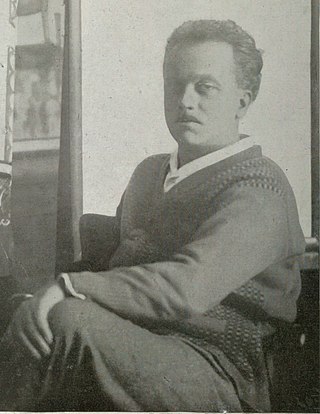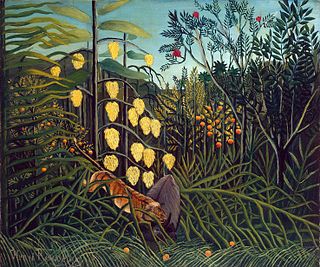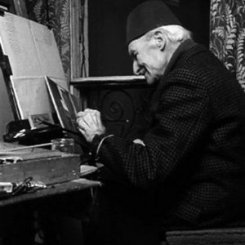
A mural is any piece of graphic artwork that is painted or applied directly to a wall, ceiling or other permanent substrate. Mural techniques include fresco, mosaic, graffiti and marouflage.

Social realism is the term used for work produced by painters, printmakers, photographers, writers and filmmakers that aims to draw attention to the real socio-political conditions of the working class as a means to critique the power structures behind these conditions. While the movement's characteristics vary from nation to nation, it almost always uses a form of descriptive or critical realism.

Raoul Dufy was a French Fauvist painter. He developed a colorful, decorative style that became fashionable for ceramics and textile designs, as well as decorative schemes for public buildings. He is noted for scenes of open-air social events. He was also a draftsman, printmaker, book illustrator, scenic designer, furniture designer and a planner of public spaces.

Gino Severini was an Italian painter and a leading member of the Futurist movement. For much of his life he divided his time between Paris and Rome. He was associated with neo-classicism and the "return to order" in the decade after the First World War. During his career he worked in a variety of media, including mosaic and fresco. He showed his work at major exhibitions, including the Rome Quadrennial, and won art prizes from major institutions.

The School of Paris refers to the French and émigré artists who worked in Paris in the first half of the 20th century.

In the arts of the Western World, Primitivism is a mode of aesthetic idealization that means to recreate the experience of the primitive time, place, and person, either by emulation or by re-creation. In Western philosophy, Primitivism proposes that the people of a primitive society possess a morality and an ethics that are superior to the urban value system of civilized people; thus, in art and in philosophy, primitivism is nostalgia for a non-existent golden age.

Fresco-secco is a wall painting technique where pigments mixed with an organic binder and/or lime are applied onto a dry plaster. The paints used can e.g. be casein paint, tempera, oil paint, silicate mineral paint. If the pigments are mixed with lime water or lime milk and applied to a dry plaster the technique is called lime secco painting. The secco technique contrasts with the fresco technique, where the painting is executed on a layer of wet plaster.

Amelia Peláez del Casal was an important Cuban painter of the Avant-garde generation.

American Regionalism is an American realist modern art movement that included paintings, murals, lithographs, and illustrations depicting realistic scenes of rural and small-town America primarily in the Midwest. It arose in the 1930s as a response to the Great Depression, and ended in the 1940s due to the end of World War II and a lack of development within the movement. It reached its height of popularity from 1930 to 1935, as it was widely appreciated for its reassuring images of the American heartland during the Great Depression. Despite major stylistic differences between specific artists, Regionalist art in general was in a relatively conservative and traditionalist style that appealed to popular American sensibilities, while strictly opposing the perceived domination of French art.
Camilo Egas was an Ecuadorian master painter and teacher, who was also active in the United States and Europe. Camilo Egas was married in Paris 1927 to Dancer and artist Margarita Gibbons. Camilo Egas museo illustrates a self portrait of the artist of 1946 that is on the cover of a pamphlet published by them then used for a book Jan 2003 edition by del Banco central del Ecuador

Shimshon Holzman was an Israeli landscape and figurative painter. He is known worldwide for his water color paintings.
Latin American art is the combined artistic expression of South America, Central America, the Caribbean, and Mexico, as well as Latin Americans living in other regions.
Jared French was an American painter who specialized in the medium of egg tempera. He was one of the artists attributed to the style of art known as magic realism along with contemporaries George Tooker and Paul Cadmus.

Villa Noailles is an early modernist house, built by architect Robert Mallet-Stevens for art patrons Charles and Marie-Laure de Noailles, between 1923 and 1927. It is located in the hills above Hyères, in the Var, southeastern France.
Jesús Guerrero Galván was a Mexican artist, a member of the Mexican muralism movement of the early 20th century. He began his career in Guadalajara but moved to Mexico City to work on mural projects in the 1930s for the Secretaría de Educación Pública and Comisión Federal de Electricidad In addition, he did easel paintings, with major exhibitions in the United States and Mexico. In 1943, he was an artist-in-residence for the University of New Mexico, painting the mural Union of the Americas Joined in Freedom, considered to be one of his major works. Guerrero Galván was accepted as a member of the Salón de la Plástica Mexicana.

Realism in the arts is generally the attempt to represent subject matter truthfully, without artificiality and avoiding speculative and supernatural elements. The term is often used interchangeably with naturalism, although these terms are not synonymous. Naturalism, as an idea relating to visual representation in Western art, seeks to depict objects with the least possible amount of distortion and is tied to the development of linear perspective and illusionism in Renaissance Europe. Realism, while predicated upon naturalistic representation and a departure from the idealization of earlier academic art, often refers to a specific art historical movement that originated in France in the aftermath of the French Revolution of 1848. With artists like Gustave Courbet capitalizing on the mundane, ugly or sordid, realism was motivated by the renewed interest in the common man and the rise of leftist politics. The realist painters rejected Romanticism, which had come to dominate French literature and art, with roots in the late 18th century.

Yehezkel Streichman was an Israeli painter. He is considered a pioneer of Israeli modernist painting. Among the awards that he won were the Dizengoff Prize and the Israel Prize.

René Rimbert was a French painter. His work is often associated with Naïve art but has influences from Neorealism, Post- and Neo-impressionism and Dutch Golden Age painting.

Gustave Miklos, also written Gusztáv Miklós and Miklós Gusztáv was a sculptor, painter, illustrator and designer of Hungarian origin. An influential sculptor involved with Cubism and early developments in Art Deco, Miklos exhibited at the Salon d'Automne and the Salon des Indépendants during the 1910s and 1920s, and in 1925 showed at the International Exposition of Modern Industrial and Decorative Arts; the exhibition from which the term "Art Deco" was derived. He became a naturalized French citizen in 1922, and a member of The French Union of Modern Artists (UAM) in 1930. In addition to his painting and sculptural works, Miklos illustrated over thirty books, designed close to 200 bookbindings, numerous posters, in addition to furniture designs.
Ofakim Hadashim is an art movement started in Tel Aviv in 1942.















